Do you want Free KIMONO? Click here and register now!
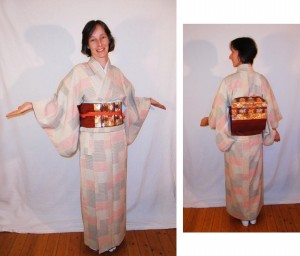
“Thank you so much! I am very excited about the prize!”
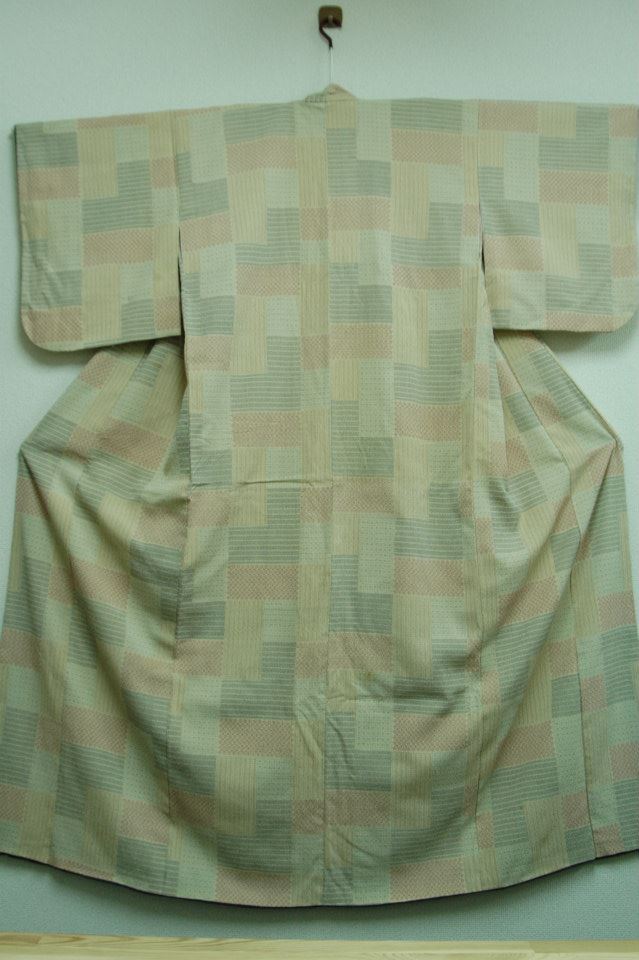
Do you want Free KIMONO? Click here and register now!

from the machi
Do you want Free KIMONO? Click here and register now!

“Thank you so much! I am very excited about the prize!”

Do you want Free KIMONO? Click here and register now!

Classic Obi
Some classic obi belts have unseen so much today.
[Round Obi]
Round Obi is defined as the origin of Fukuro obi, which is consisted of cloth for obi wholly and the lining is not used.
Though it is extremely gorgeous, it is heavy for that and hard to be fastened. So Fukuro obi which is modified from round obi, has been prevalent. Today, Round obi is used for only bridal. The size is the same as Fukuro obi, so it is fastened as double-drum or fancy-form as Fukuro obi.
[Day-Night Obi]
Day-Night Obi is, what is now called reversible obi, generally made of bright-colored cloth on the front side and black cloth on the back side. The bright cloth is regarded as daytime, and black one is night, which is called Day-Night Obi.
Day-Night Obi is a reversible belt, but it is not used changing one side to another; in fact, it is made to be fastened beautifully when the knot is made to show the back side called “hocking knot” or “pulling knot”. Thus, the feature of the obi is longer than present Nagoya obi and shorter than Fukuro obi in order to fit the knot.
Do you want Free KIMONO? Click here and register now!

“Oh my gosh!!! Thank you so much!!!”
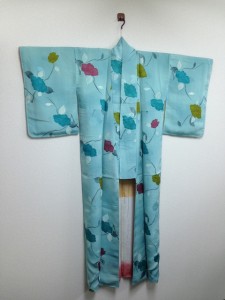
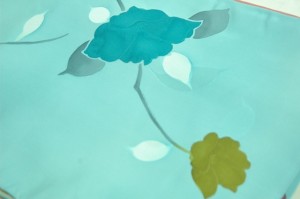
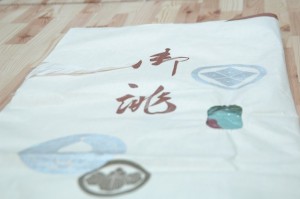
Do you want Free KIMONO? Click here and register now!
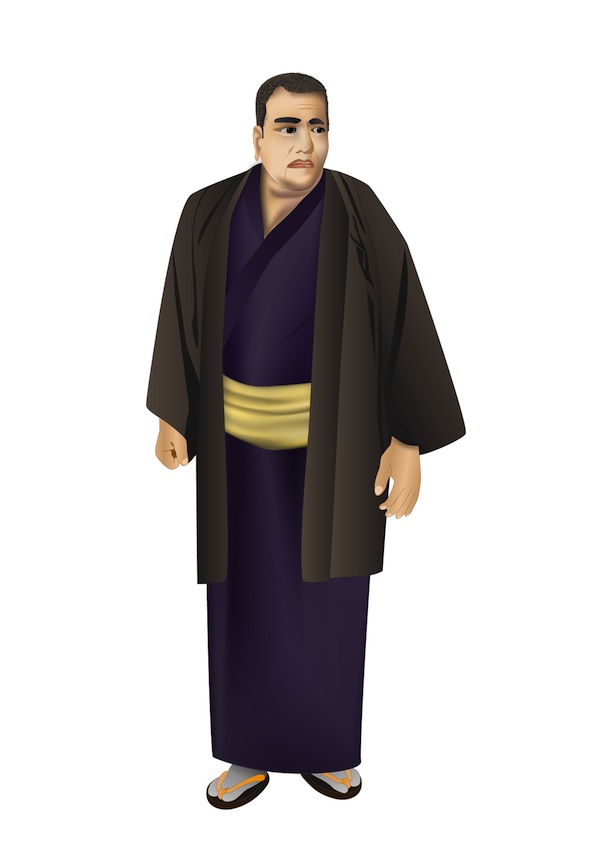
Kaku-obi is most often used by men. It’s used under the formal hakama, and with normal yukata. It’s usually about 10 cm wide and 4 m long, so it’s even thinner than the half-width obi used by females. It can be made from many materials, and most of the ones used to make the obis for women can be used to make kaku-obi as well. Kaku-obi are often seen with Hakataori-style kimonos, but you don’t necessarily need to use one of them – because kaku-obi are easy to tie and lightweight, they can be easily combined with any kimono and so they are very popular among the buyers.
Please choose one that matches your kimono and yourself. You tie it with a kai no kuchi knot. This doesn’t mean that it has to be that way, but the finished shape became popular as it’s easy and hard to become loose. Other well-known methods are katabasami, ichimonji, and kandamusubi. Incidentally, the tip of kakuobi may have a tassel. Usually, it’s cut and the tip is inserted, but some people use it to decorate it. Either is fine.
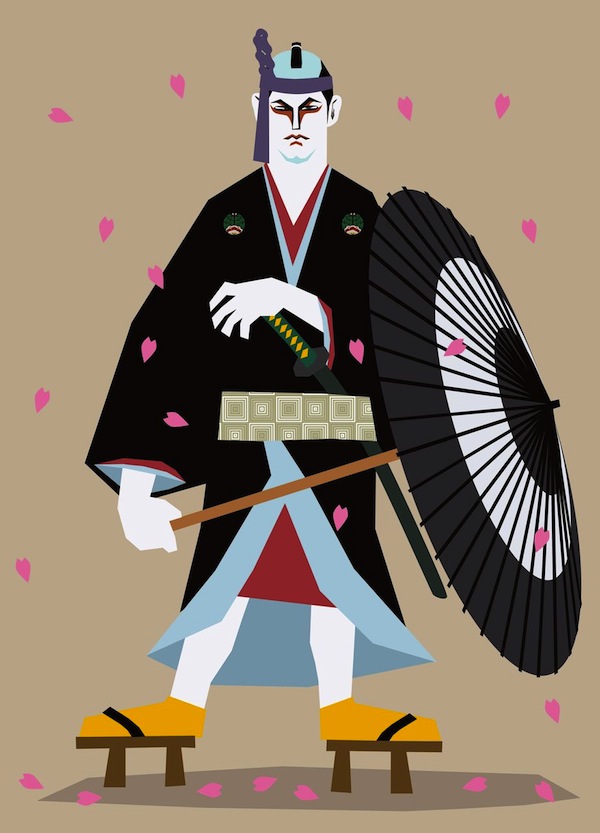 Heko-obi was originally an obi (kimono sash) used by men. It was made from simple, big soft cloth. Presently, it’s often used with children kimonos and women’s yukata.The “tiny heko” that has been popular for the last few years is a decorational cloth based on the concept of heko-obi, and doesn’t function as a normal obi.
Heko-obi was originally an obi (kimono sash) used by men. It was made from simple, big soft cloth. Presently, it’s often used with children kimonos and women’s yukata.The “tiny heko” that has been popular for the last few years is a decorational cloth based on the concept of heko-obi, and doesn’t function as a normal obi.
There aren’t any regulations regarding it’s size, but usually it’s 50 cm wide and 3.5 m long. It’s lighter and softer compared to other obi, so children like it because it doesn’t strain their bodies.
On the other hand, because it’s one of the most simplified versions of obi, it is only used with everyday kimonos. It’s never used in more formal situations.As opposed to other obi, this one is usually tied in a bow. You can also tie it into more showy knots, but it is usually tied into a bow.
Because you don’t use any extra strings to tie it and it keeps in one place just tied into a bow, the most important thing is that it doesn’t slide easily. It is usually made from materials whose surface is uneven, such as silk crepe or tie-dye, which makes them harder to slide down. They also add some volume and fluffiness to the obi, which makes it even more beautiful.
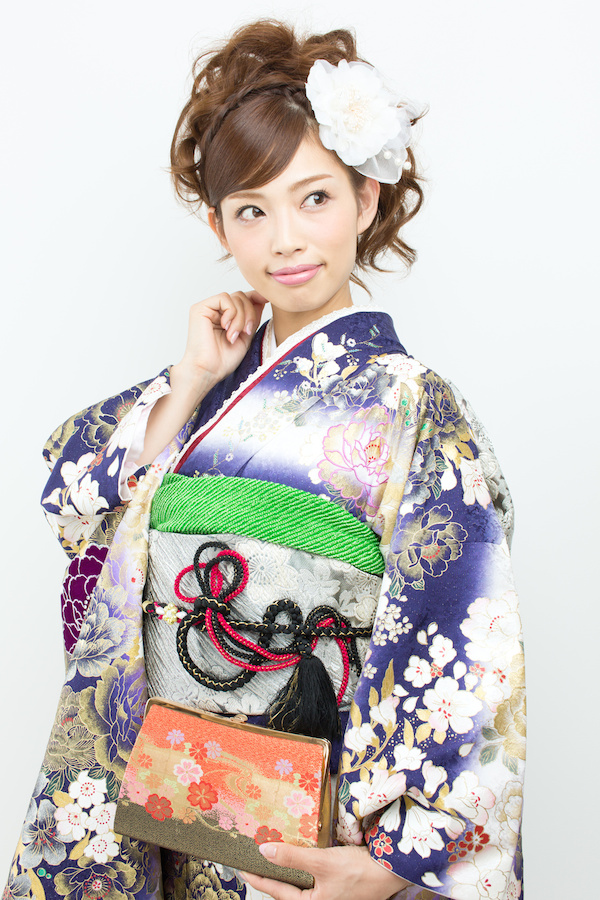
Otaiko is the abbreviation of “Otaikomusubi”, which is the most general shape now. It also indicates a square part of otaikomusubi on your back. The edges of obi below otaiko is called “Tare”.
There are two types of otaikomusubi- “Futae (double) taiko” and “Hitoe (single) taiko”. Normally, hitoe taiko is called “Otaiko”. When you compare it with futae taiko, it is called “Hitoe taiko”. Futae taiko means that the obi is double at otaiko part. Hitoe taiko’s obi is single at otaiko part.
In addition, there is “Kozutsumi taiko” way of tying a knot when you can’t make futae taiko because there is not enough length of fukuro-obi. The history of Otaikomusubi is unexpectedly short. It began was when Taikobashi of Kamedotenjin was built at the end of Edo period. A group of geisha girls tied a knot like Taikobashi and crossed the bridge for the first time. And this knot came into fashion later.
The size of otaiko is not specified in particular. It can be changed depending on the height and taste of the person who wear it. It also depends on fashion. It is also important that the pattern of obi should be shown beautifully.
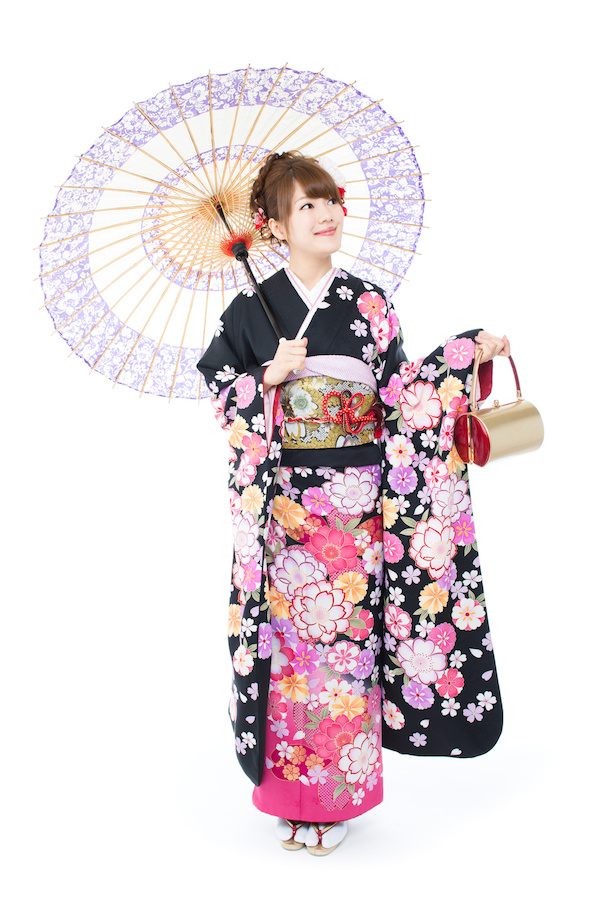
There are three ways patterns are arranged on kimono sashes.
Zentsu Pattern:
The entire sash is covered in a specific pattern, which is commonly a repeated pattern. Since any part of the sash can be placed in the front and it can be used in Otaiko knots, these types of sashes can be recommended for beginners. However, the main drawback is that Zentsu sashes can be thicker and heavier than other sashes.
Rokutsu Pattern:
The pattern on a Rokutsu sash covers less area than on a Zentsu sash. The areas that will be covered up when tied around the torso are plain and unadorned. Not only are they cheaper than Zentsu sashes, they are easy to tie and they are light, which is why they are currently the most common type of kimono sashes in use.
“Rokutsu” means “six pass,” which means the pattern cover only six-tenths of those sashes. Although a lot of people don’t use it, there are also Yontsu sashes in which only four-tenths of the area is covered in a pattern.
Otaiko Pattern:
It is also called the “Point Pattern.” The pattern is only placed on the part of the sash that will be seen in the rear part of an Otaiko knot, but there are many sashes that also have patterns that will be seen in the front part (the abdomen) as well. Those particular patterns are called “haramon.” These sashes are popular because they can create a picturesque presentation, but tying these sashes so that the patterns can be seen neatly will take some getting used to.
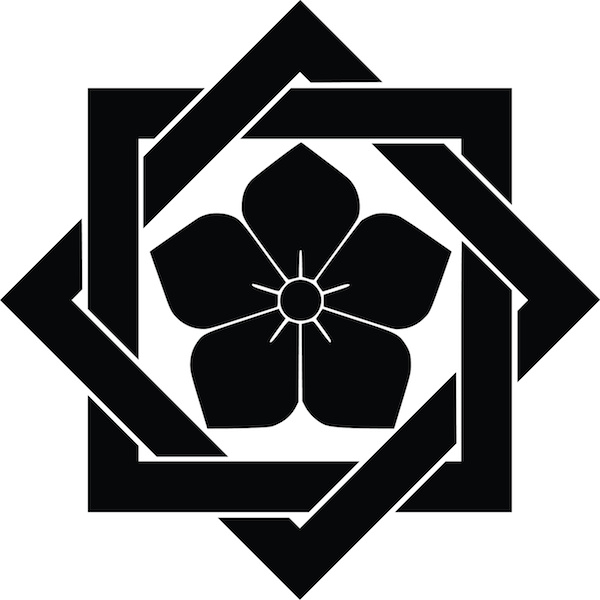
In the case of inserting crests in kimonos, those “crests”mean family crests. Family crests are took over through many generations and the common people have come to begin using them since the Edo era.
Traditions of family crests differ from region to region.And after women marry their husbands,whether husbands’ ones will be used for family crests or women’s ones will depends on colors their families have.So if people insert crests in kimonos,they follow their parents’ and parents-in-law’s decisions which ones they should use.
In Japan,especially in Kanto region,you can find the habit of using Onnamon as family crests many times. This is the crest inherited from mother to her daughter; the other region, however, might simply call a parents’ family crest of women as the onnnamon.
Speaking of putting a family crest on kimono, there is no chance for a dress for hire. Moreover, foreigners do not have a family crest in the first place, and there are also people who do not know their family crest for the past prolonged period of time.
In that case, they may use widely used crests called “torimon” (crest not related to a family) or newly designed ones.
These torimon and newly designed crest might be called onnamon.

Among the kimono patters, there is the so-called “shikunshi”, which represents happiness and auspiciousness. This pattern consists of four types of greenery: orchids, bamboo, chrysanthemum, and plums.
They were especially treasured in China, where it was said that their refined beauty was akin to that of a wise man with wonderful personality (kunshi) and so the combination came to be known as shikunshi, which means “four wise men”. What’s more, orchids represent spring, bamboo represents summer, chrysanthemum – fall, and plums are the symbol of winter.
This pattern isn’t used only in the world of kimonos – there are often drawn together as a set, and the combination is often used as a fundamental topic for practice in ink painting.
Plums, orchids, bamboo and chrysanthemum often appear in kimono patterns independently, and the general rule is that you should wear them during the season the given pattern represents. However, when all of them are included in a pattern, they can be worn all year long.
There are also other patterns that combine motives from different seasons, like chrysanthemum and cherry blossoms, or butterflies and red leaves, to make it possible to wear them all year long.
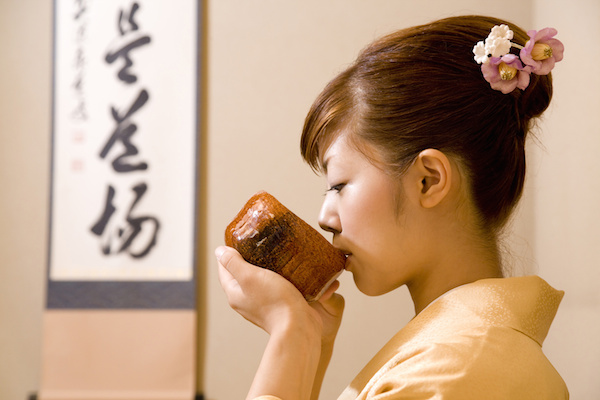
Tea ceremony and kimonos are deeply connected to each other. There are many elements of the tea ceremony that assume you are wearing a kimono while performing it – for example, at some point while preparing tea, you take out your fukusa (a small cloth for wiping tea utensils) out of your kimono’s breast pocket and then put it in your obi. That’s why there are many people knowledgeable about kimonos among the tea ceremony experts.
On the other hand, because kimono is not longer something people wear everyday, it wouldn’t be practical to ask people learning tea ceremony to wear it every time. That’s why many changes were introduced to allow people to take part in tea ceremony while wearing western-style clothes.
An representative example would be the so-called “keikogi”, which is shaped like a vest and it looks as if it was made from sleeves detached from a kimono. Those who are thinking about learning tea ceremony should ask their teachers about the specifics and not decide anything on their own, because the rules change from teacher to teacher.
It is also not necessary to wear a kimono if you were asked to participate in a tea ceremony as a guest. The spirit of tea ceremony says to welcome every guest in the same way regardless of their clothes. Of course, if you come to a tea ceremony wearing a kimono, it would surely make the organizers happy, so if it’s possible, we recommend putting one on.